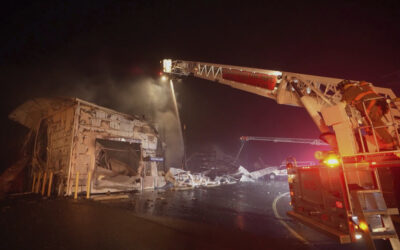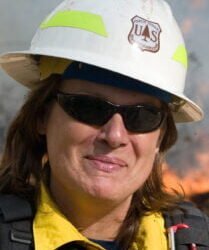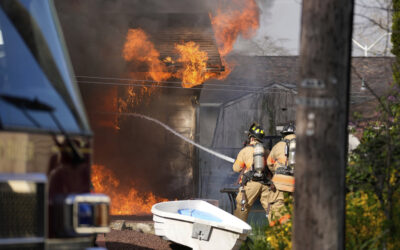Most fire districts that reside in the wildland urban interface (WUI) are in danger of a catastrophic loss from wildland fire. The lack of defensible space around homes could lead to millions of dollars in property losses and potential civilian casualties.
A practical solution to this problem is to investigate the practices currently in place by fire departments of equal size and constructs. Questions to ask to guide the research include the following:
- Do local homeowners know what defensible space is?
- What policies do homeowners or homeowners associations (HOAs) currently have in place for defensible space?
- What requirements are HOAs willing to adopt for defensible space if they do not already?
- What do fire departments similar to yours have in place for policies or ordinances for the defensible space of structures?
- What programs do similar fire districts have in place to assist customers in creating and maintaining defensible space around structures?
The result of the research can show a connected or disconnected methodology with current practices of defensible space between your fire department and the community. The research may show that most HOAs and fire departments need a policy in place that defines and implements defensible space.
Defensible space is widely known in the WUI industry as an area around a home or group of homes that creates a tactical advantage for firefighters that can either safely defend a home from a wildland fire or the home can temporarily survive a wildland event with little to no hazard mitigation. Fire departments often spend time and resources educating their community with frustrating results until there is a major event looming on the horizon. Fire departments throughout the country often use a best-practices approach that is self-fulfilling and cost-effective for their region. The best practices are often captured by national standards such as the International Association of Fire Chiefs (IAFC) “Ready, Set, Go” program1 or the current National Wildfire Coordinating Group (NWCG).
Organizations in the fire service adopt these digestible concepts for defensible space in their community. This methodology is rarely executed but is referenced when a homeowner or community planner asks questions about defensible space. This can create confusion from a consistency standpoint when addressing community safety.
Most fire departments and districts have a system in place to educate customers on defensible space. The current recommendation largely involves telling homeowners to create 30 feet of defensible space around the home by clearing all combustible materials and instituting manicured irrigated lawn.
There are some scenarios where the homeowner does not want to clear all mature natural trees to preserve esthetic value. In these instances, it is recommended for the homeowner to thin the trees to yield approximately 30 to 40% of canopy coverage on the forest floor and to trim all ladder fuels of the mature trees a minimum of 15 feet from the ground. Homeowners are also encouraged to create three feet of noncombustible space around the home using washed rock or stone and ornamental vegetation that does not produce decaying debris around the plant. It is recommended that all lawns are maintained and irrigated and long, native vegetation is kept short around the home.
It is not in the scope of this article to highlight various construction techniques to help with a defensible tactic when protecting a home. However, it is important to note what the customer can accomplish with hazard mitigation as it pertains to organic matter. There needs to be a system in place to deliver sound education strategies to the customers to further educate them on proper defensible space practices to yield a safer environment for the firefighters and community. This will benefit all parties on an incident by creating consistency across a community at risk.
The United States Fire Administration (USFA) is dedicated to working with state and local departments by providing education to help communities reduce loss of property and life.2 This research coincides with the USFA’s goals of ensuring readiness of the nation’s fire and emergency services for all hazards.2
Another goal of the USFA is to reduce risk and improve resiliency through programs and training.3 These programs include Executive Analysis of Community Risk Reduction, which steers the student to identify and capture research to create a strategic community risk reduction plan.3
The IAFC has provided guidance in supplying communities with best practices while residing in the WUI. It has provided leadership to the federal, state, local, and private sector on programs such as “Ready, Set, Go.”1 One of its key objectives is to provide a standardized approach to educating community members on defensible space.
The IAFC highlights defensible space into three zones:
- Zone 1 around a structure is defined as 0 to five feet around the home. The homeowner should use landscape techniques to incorporate hard surfaces such as concrete or noncombustible rock mulch, clear roofs and gutters of dead leaves and debris, store firewood away from the home, and trim back touching or overhanging branches from the roof at least 10 feet.1
- Zone 2 around a structure is five to 30 feet around the home. The homeowner should use low-growing herbaceous vegetation, create vegetation islands to break up continuous fuel, and remove ladder fuels.1
- Zone 3 is 30 to 200 feet around the home. The homeowner should create 10 feet between the tops of trees, remove ladder fuels to create a separation between low-level vegetation, and remove dead trees and shrubs.1
In addition, several state and local governments have created laws to determine minimum distances of defensible space for homeowners and communities. In January 2005, California created the Defensible Space/PRC 429, which determined the defensible space around homes and structures must be 30 to 200 feet.4
For almost two decades, the residential growth in the WUI has increased at an alarming rate. The number of homes that abut or are in the interface has grown at an alarming rate. The Northern Research Station from Newton Square, Pennsylvania, partnering with the National Academy of Sciences (2010), showed the number of homes grew from 30.8 million to 43.4 million in the WUI, a 41% increase from 1990 to 2010.
The fire service and end users need to understand that it is a collaborative effort to reduce hazards around homes in the WUI to reduce loss of lives and property. To effectively preplan the home, street, or subdivision to make the overall HOA a safer place to live and operate is imperative. This planning comes from understanding what past, current, and future practices are to ensure a safer home in the WUI.
The planning starts with evaluating the current threat of a wildfire and whether that community is resilient to it. Not all communities in the WUI have a need for hazard mitigation. The ones that do need to understand the why behind current strategies. If the communities have a clear picture of what can be saved or defended, this will result in a more communitywide approach, and continuity will be achieved.
There are several guidelines to assist homeowners and emergency planners in the WUI that FIRESCOPE has identified. The constant theme is defensible space and enough of it to position a fire apparatus to be safe. Other factors like forecasted fire behavior and intensity and safety zones come into play when determining what is enough space. These critical factors are very important to consider when determining what is a safe and defensible home. What is most important is to convey this information to the customers so they understand the methodology and capabilities of the first responders. If there is transparency with information shared between the homeowners and the responding agencies, consistency can be obtained to have community continuity of defensible space in the WUI.
Many nationally and internationally recognized organizations have similar qualifications for defining minimum requirements for defensible space and hazard mitigation in the WUI. The NWCG and the IAFC have both produced strategies for defensible space. The NWCG suggests that defensible space should be 30 feet of cleared area around a structure with minimal ignitable vegetation.5 The IAFC’s “Ready, Set, Go” program expands on the concept and relays that defensible space should be 30 to 100 feet around a structure with minimal combustible vegetation.1 Although factors of the requirements seem to have a consistent thread, there still is no “one way” of doing things for agencies operating in the WUI. The literature reviewed in this research all points to a common thread: a need for a standardized methodology for defining what defensible space is and what the requirements are.
Endnotes
1. International Association of Fire Chiefs (IAFC). (2018). Ready Set Go. Billings, MT: Author.
2. United States Fire Administration (USFA). (2019). A Prepared and Resilient Fire and Emergency Medical Services. Retrieved from: https://www.usfa.fema.gov/downloads/pdf/publications/strategic_plan_2019-2023.pdf.
3. International Association of Fire Chiefs (IAFC). (2016). NFA’s Growing Impact on Community Risk Reduction. Retrieved from: https://www.iafc.org/iCHIEFS/iCHIEFS-article/nfa-s-growing-impact-on-community-risk-reduction.
4. CAL FIRE (2020). Defensible Space/PRC 4291. Retrieved February 1, 2020 from https://www.fire.ca.gov/programs/communications/defensible-space-prc-4291/.
5. National Wildfire Coordinating Group (NWCG). (2017). Wildland Urban Interface Wildfire Mitigation Desk Reference. Boise, ID: Author.
Photo from PxHere.
Seth Barker is the deputy chief of operations for the Big Sky (MT) Fire Department. He is a logistical coordinator for FireFighterCloseCalls.com and has contributed to the 16 Life Safety Initiatives for the National Fallen Firefighters Foundation. He sits as the vice-chair for the Volunteer Combination Officer Section for the International Association of Fire Chiefs Cancer Alliance Committee. Barker is one of the contributing authors for the Lavender Report issuing the 11 Best Practices of Cancer Prevention in the Fire Service. He serves as the 1st vice president for the International Society of Fire Service Instructors and holds the Fire Officer and Chief Training Officer designations from the Center of Public Safety Excellence. He recently received the Jim Blankenship Award from the Montana State Fire Chiefs Association for excellence in fire training.




